Overview of modern electric heating radiators: affordable heat in every home
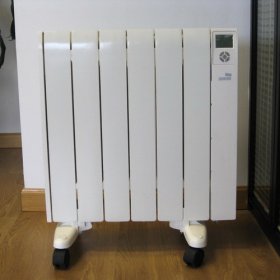
With the onset of cold weather, there is an increase in public interest in heating issues. This is understandable, because the level of comfort in apartments and houses depends on the normal operation of heating systems. But, as you know, at the beginning of the heating season there are a lot of problems associated with the heating system: accidents on heating mains, gas interruptions, cold batteries in the apartment, etc. To provide the house with heat in case of emergency shutdowns of the central heating system, an alternative heat source must be available. An effective way to heat rooms in cold weather is an electric heating system. Its main elements are electric heating radiators. Due to various circumstances, some buildings can only be heated with electricity. Therefore, it will be useful for many to learn as much as possible about these devices: their device, classification, operating principle, advantages and disadvantages.
Content
Types of Electric Heaters
Today in many countries exclusively electric appliances and heating systems are used. Among them - France, Finland, Austria, Montenegro and others. Therefore, the range of electric heaters on the market is very large.
All electric radiators are divided by location and size into ceiling, wall and floor. There are varieties like skirting narrow, skirting floor and newfangled models of glass and ceramic radiators.
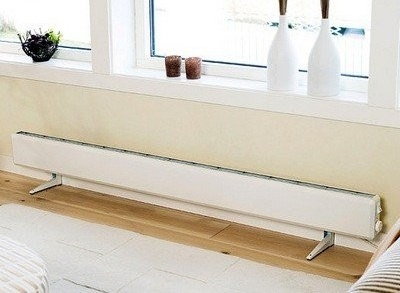
Plinth low electroconvectors are convenient for installation in hard-to-reach places (under low windows, under stained-glass windows, etc.)
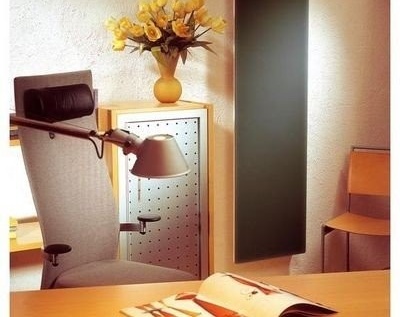
Glass electric radiators are a combination of high advanced technology and aesthetic beautiful appearance. They consist of two plates of durable glass that provide heat radiation
By the nature of heat transfer and design features, modern electric radiators are divided into the following types:
- fan heaters;
- oil electric radiators;
- convectors;
- infrared heaters.
Consider the characteristics of each of them.
Option # 1 - fan heater
This electric heater consists of two main parts - a fan and a heater. The fan allows air to be pumped through the heating element or the heating chamber. Heated air is driven by a fan and quickly spreads around the room. As heating elements, spirals or tubular heaters - tena are used. The thermostat mounted in the device switches off the device when a pre-set temperature is reached.It may also include a fan speed controller, and a timer to set the operating time. This will save the device from overheating during prolonged use.
The advantages of such units are only a quick heating of the air and the ability to maintain temperature in relatively large rooms. There are quite a few disadvantages: the burning of oxygen in a room, the consumption of a large amount of electricity, the inability to use in rooms with high humidity.

The fan heater is suitable for quick heating of the room. Its heating element is heated in a short time to a high temperature and forced injection of hot air spreads it throughout the surrounding space.
Read more about these units in the article: How to choose a fan heater: classification of units + what to look at when buying?
Option # 2 - oil cooler
The interior of this radiator is filled with mineral oil. The heating element heats the oil, and it transfers heat through the housing to the environment. Since there are no open heating elements in such devices, oxygen from the air and small dust particles are not burned. The advantages of such devices are mobility, fire safety, silent operation, and the minuses are the high temperature of the surface of the electric radiator, uneven heating of the room, and considerable dimensions.
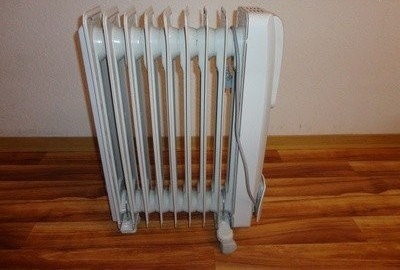
Oil radiators are reliable, safe and completely silent. This heater option is ideal for home and office, as well as for giving in the winter
Read more about these units in the article: Which oil heater is better: we analyze the criteria for choosing units.
Option # 3 - convectors
The principle of operation of the convector is based on the laws of physics, according to which cold air always goes down and penetrates the lower grill of the unit. Passing through the heating elements, the air warms up, becomes lighter and rises. The upper layers of air cool down and become heavier, so they sink down. The convection cycle repeats over and over. Continuous air movement creates a comfortable temperature in the room.
The convector itself consists of a metal casing with heating elements integrated inside, controlled by automatic temperature regulators and special timers. The convector does not burn oxygen and does not dry out the air, is immune to moisture, safe and does not require self-control, is easily mounted. Its only drawback may be only the lack of a suitable place for installation.
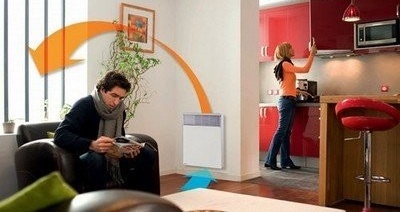
Electric convectors are necessary for heating rooms in cold weather with poor central heating in apartments
Read more about these units in the article: Which electric heating convector is better: how to buy a good one, so as not to regret it later?
Option # 4 - infrared radiators
This type of radiator is a fairly new type of heating, but its use is gaining momentum. Its main difference from other electric heaters is that these devices do not heat the air in the room, but the objects surrounding them. This is done using electromagnetic waves of a certain frequency. And interestingly, the device remains completely cold.

A distinctive feature of the infrared radiator is its ability to heat with the help of infrared waves not air, but near objects, while its body remains cold
Like convectors, infrared heaters are equipped with an automatic shutdown sensor, a thermostat, and floor models also have a shutdown sensor in the event of a rollover.
For interesting information about these heaters, see the article: What harm can an infrared heater cause?
Why is it worth using electric heating?
To the above advantages of electric heaters, one should add the numerous advantages of using electricity-powered heating:
- Creating a multi-section system of several radiators does not require large expenditures, but there is a guarantee of heating a large room in a short time. Installation of such a system is quite simple.
- The closed system provides a human-friendly microclimate, does not dry the air, does not attract dust. Electric batteries are compact, do not occupy much space in the room, do not require special skills and additional equipment for installation.
- In the process of such devices use environmentally friendly material that does not pollute the environment. There are no combustion products, rooms do not smoke, the noise level during operation is minimal.
- Modern electric batteries are safe.
- Failure of one radiator does not entail a shutdown of the entire system. It will operate in the same mode until the damaged compartment is repaired or replaced.
- Installing the system under window blocks eliminates heat loss through window leaks.
- This is an effective way of heating rooms in which the use of other types of fuel is prohibited by safety precautions.
- In frosty times, this is an excellent way out in the event of an accident on heating systems.
- The ability to accurately calculate the level of heating separately for each room, taking into account its area, and choose the number of sections individually.
- Electrical appliances with special software are the best suited for homes with a restriction on the supply network. With the right power source, they are able to function without manual control, which means without human intervention.
- Due to the attractive appearance, electric radiators become part of the interior of the room.
- The system works from a universal power source under voltage 220 V.
It is important to note that the heating system must be selected at the design stage of the building.
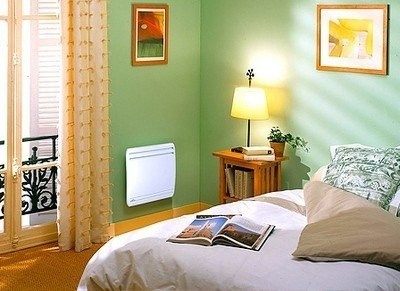
Modern wall-mounted electric radiators are small and attractive in appearance, so they become part of the interior of the room
An irreplaceable electric battery will be at the recreation center, at the cottage, in other structures of the seasonal stay. The installation of heating in such rooms is irrational due to the need for seasonal maintenance, draining the coolant for the winter and, finally, because of the high cost. And electric heaters make it easy to heat rooms, moreover, economically, conveniently and safely.
Power calculation and safety rules
The most important parameter when choosing an electric radiator is power. Knowing its value, you can calculate the required number of radiators for each room individually and for the whole house. And the total power indicators will help determine the full amount of heating costs.
We give the simplest calculation of power. To heat a room of 20 m2 heater power of 1.5-2.00 kW is required. Therefore, for a house with a total area of 100m2, you will need five heaters with a total capacity of 10 kilowatts. But such a calculation is approximate. For a more accurate calculation, you need to consider many factors, such as:
- thermal conductivity of floor, wall and ceiling materials;
- the presence of heat leakage paths (doors, open windows, ventilation ducts);
- requirements for the desired temperature;
- type of device, methods of thermoregulation and connection used in it;
- power supply parameters.
Also, here are some general tips that apply to electric heating equipment:
- When choosing a convector equipped with an electronic thermostat, preference should be given to well-known brands - this will be a kind of guarantee for the durability of heating electrical equipment.
- It is necessary to fulfill the requirements of manufacturers when installing a radiator - the nearest outlet should be located at a distance of at least 10 cm from it, moreover from below or from the side, and not from above.
- Do not allow the power supply cable to come into contact with the convector body, the distance between the wall and the heating device during stationary placement should not be less than 5 mm.
- It is forbidden to cover the convector upper grill with any things - they will not be able to dry them on this appliance, as an emergency shutdown sensor is immediately activated as a result of overheating.
For the correct selection and installation of heating electrical equipment, it is better to consult a specialist - this will help to create an effective and safe system.

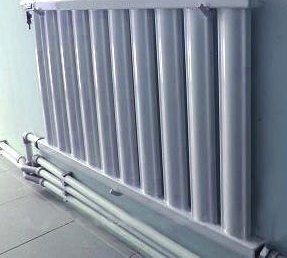

2 comments